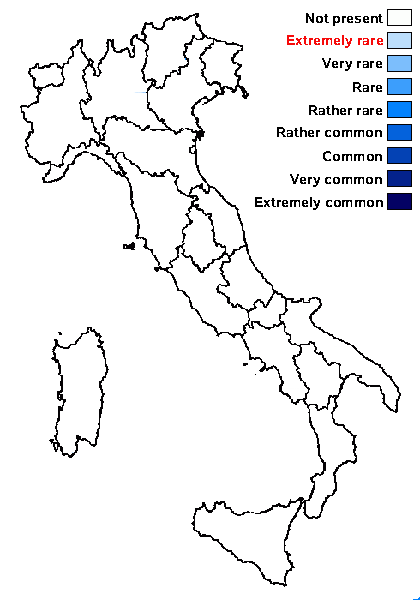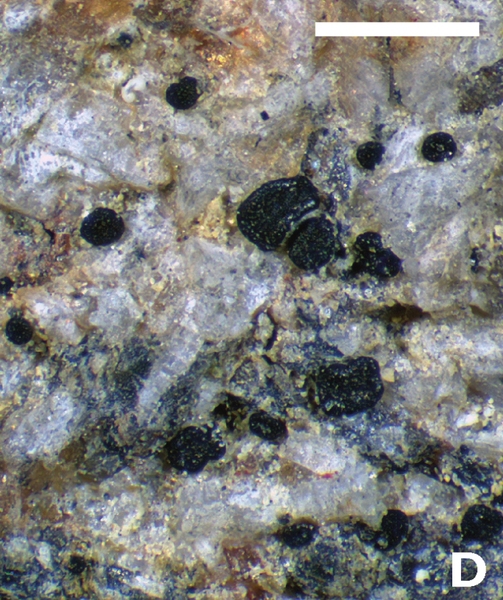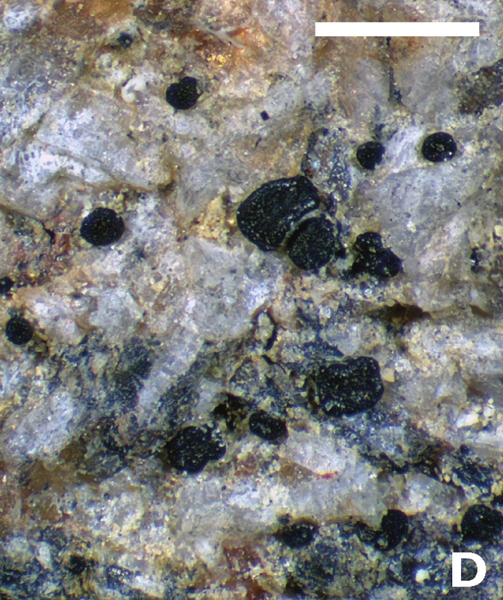Leimonis lynceola (Th. Fr.) Aptroot
Index Fungorum, 331: 1, 2017. Basionym: Lecidea lynceola Th. Fr. - Lich. Scand., 2: 561, 1874
Synonyms: Micarea excipulata Coppins; Micarea lynceola (Th. Fr.) Palice
Distribution:
Description: Thallus crustose, very thinly episubstratic, inconspicuous, effuse, very pale brown to dull greenish, the prothallus absent or poorly evident. Apothecia biatorine, numerous, black when dry, bluish grey when wet, flat to slightly convex, not tuberculate, 0.15-0.4 mm across, with a thin, soon excluded proper margin. Proper exciple well-developed, especially in young apothecia, 30-40 μm wide laterally, pale bluish green, aeruginose or olivaceous in outer part, colourless within, of radiating and branched, paraphysis-like hyphae, K/I-; epithecium poorly differentiated from the hymenium, bluish green or olivaceous, K-; hymenium colourless, 38-45 μm high, K/I+ blue; paraphyses rather scarce, monomorphic, sparingly branched, 1-1.3 μm thick at mid-level, only slightly widening toward apices, the apical cells up to 1.7 μm wide; hypothecium colourless or pale olivaceous green. Asci 8-spored, cylindrical-clavate, the I+ blue tholus with a wide, intensely I+ dark blue tube structure that expands towards the top, without a pale axial body. Ascospores 1-celled, hyaline, ovoid, (6-)7-9(-10) x 3-4(-5) μm. Pycnidia scarce, inconspicuous, immersed, 0.03-0.04 mm wide, black, the wall dark green, K-. Conidia 3-5 x 0.8-1 μm. Photobiont chlorococcoid, the cells 7-15(-20) μm wide. Spot tests: thallus K-, C-, KC-, P-, UV-. Chemistry: thallus without lichen substances.Note: a pioneer, ephemeral species usually growing on loose siliceous pebbles, often in disturbed habitats such as along mountain trails in humid situations; widespread in Europe but not common, perhaps often overlooked, with a single record from the Eastern Alps (Carinthia, Austria); to be looked for in the Italian Alps.
Growth form: Crustose
Substrata: rocks
Photobiont: green algae other than Trentepohlia
Reproductive strategy: mainly sexual
Pioneer species

Predictive model
Growth form: Crustose
Substrata: rocks
Photobiont: green algae other than Trentepohlia
Reproductive strategy: mainly sexual
Pioneer species

Predictive model
 INDEX FUNGORUM
INDEX FUNGORUM
 GBIF
GBIF



